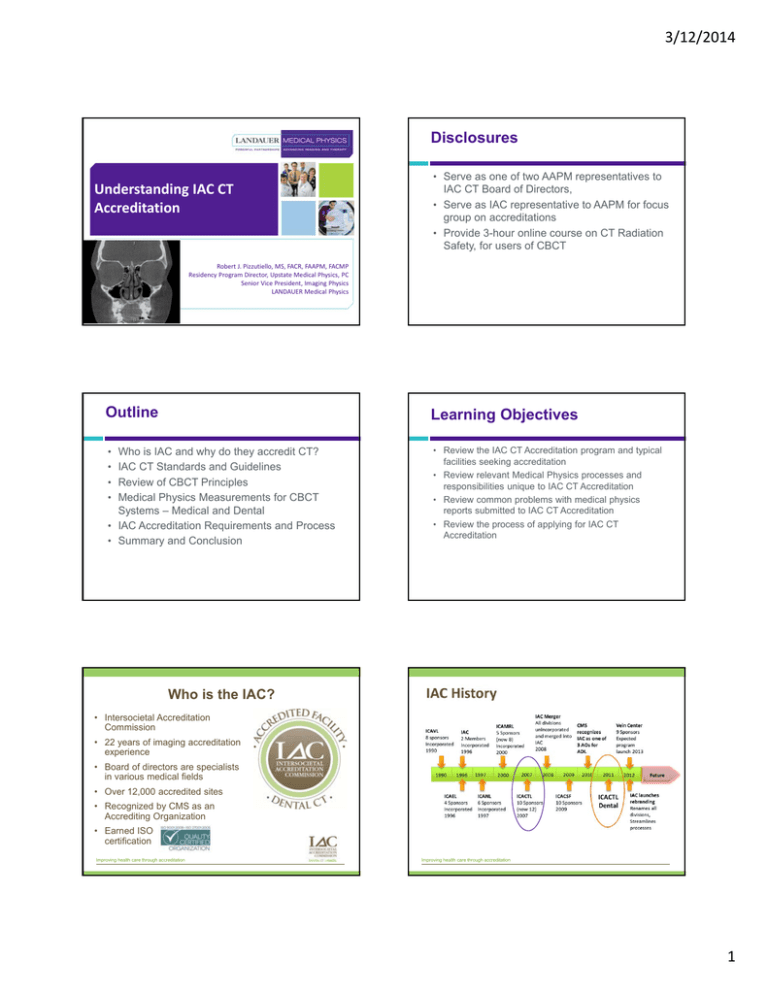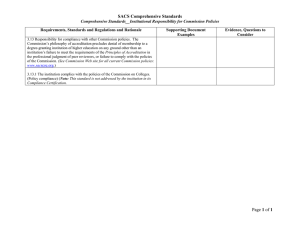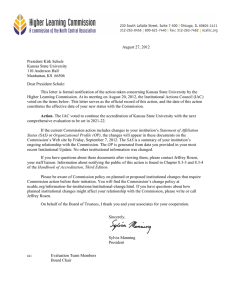3/12/2014 Understanding IAC CT Disclosures
advertisement

3/12/2014 Disclosures • Serve as one of two AAPM representatives to Understanding IAC CT Accreditation IAC CT Board of Directors, • Serve as IAC representative to AAPM for focus group on accreditations • Provide 3-hour online course on CT Radiation Safety, for users of CBCT Robert J. Pizzutiello, MS, FACR, FAAPM, FACMP Residency Program Director, Upstate Medical Physics, PC Senior Vice President, Imaging Physics LANDAUER Medical Physics Outline Learning Objectives Who is IAC and why do they accredit CT? IAC CT Standards and Guidelines Review of CBCT Principles Medical Physics Measurements for CBCT Systems – Medical and Dental • IAC Accreditation Requirements and Process • Summary and Conclusion • Review the IAC CT Accreditation program and typical • • • • facilities seeking accreditation • Review relevant Medical Physics processes and responsibilities unique to IAC CT Accreditation • Review common problems with medical physics reports submitted to IAC CT Accreditation • Review the process of applying for IAC CT Accreditation Who is the IAC? • Intersocietal Accreditation Commission • 22 years of imaging accreditation experience • Board of directors are specialists in various medical fields • Over 12,000 accredited sites • Recognized by CMS as an Accrediting Organization • Earned ISO certification Improving health care through accreditation Improving health care through accreditation 1 3/12/2014 IAC CT Sponsoring Organizations IAC Vascular Testing | ICAVL - 1990 Echocardiography | ICAEL- 1996 Nuclear/PET | ICANL - 1997 MRI | ICAMRL - 2000 CT | ICACTL – 2007 Dental CT | ICACTL - 2011 Carotid Stenting | ICACSF - 2009 Improving health care through accreditation • American Academy of Neurology (AAN) • American Academy of Otolaryngology — Head and Neck Surgery (AAO-HNSF) • American Academy of Oral and Maxillofacial Radiology (AAOMR) • American Association of Oral and Maxillofacial Surgeons (AAOMS) • American Association of Physicists in Medicine (AAPM) • American College of Cardiology (ACC) • American Society of Nuclear Cardiology (ASNC) • American Society of Radiologic Technologists (ASRT) • Society for Cardiovascular Angiography and Interventions (SCAI) • Society for Vascular Surgery (SVS) • Society of Cardiovascular Computed Tomography (SCCT) • Society of Nuclear Medicine and Molecular Imaging (SNMMI) • Radiology at large members Vein Center - 2013 Improving health care through accreditation Payment Policies Benefits of Accreditation • • Commitment to quality • Recognition of your skills – High quality services – Patients • Educational tool – Continuous quality improvement Improving health care through accreditation MIPPA Law 2008 – Nuclear, PET, MRI, CT – Accreditation required by 1/1/2012 – 120 day CMS grace period – for adding new sites if currently accredited – Includes dentists that utilize CT scanners – Oral surgeon penalized by CMS for Medicare billing without accreditation • Private Insurers and State programs – Some private insurers may require accreditation – California (CT), Minnesota (CT, Nuc/PET,MRI) Improving health care through accreditation CT MR NM PET Total GAO-13-246 5-31-13 Establishing Minimum National Standards and an Oversight Framework Would Help Ensure Quality and Safety of ADI services 2 3/12/2014 Outline intersocietal.org/ct Who is IAC and why do they accredit CT? IAC CT Standards and Guidelines Review of CBCT Principles Medical Physics Measurements for CBCT Systems – Medical and Dental • IAC Accreditation Requirements and Process • Summary and Conclusion • • • • Improving health care through accreditation CT Standards • Dental staff training and experience requirements • Patient and employee safety policies • Equipment QC • Radiation oversight and safety adherence • Report content • Quality improvement program Physics Guidance • Radiation Protection Survey • Image Quality and Dose Assessment Improving health care through accreditation Improving health care through accreditation Improving health care through accreditation Improving health care through accreditation http://www.intersocietal.org/ct/main/ct_standards.htm 3 3/12/2014 IAC Standards and Guidelines for CT Accreditation Part I - Organization Improving health care through accreditation 1. Which of the following is not true about the IAC CT Accreditation program? 20% a) 20% b) 20% 20% c) 20% d) e) Anyone with a BS degree or higher may perform CT annual medical physics surveys The initial radiation protection survey must include measurements and calculations of exposure to persons in the vicinity of the scanner Image quality evaluations must include slice thickness, uniformity, noise, and other parameters using a phantom chosen by the medical physicist Dosimetry must include measurements and comparison with appropriate benchmarks, chosen by the medical physicist The IAC CT Guidance document describes what 10 is expected of the medical physicist Outline http://www.intersocietal.org/ct/standards/IACCTStandards2012.pdf Improving health care through accreditation 1. Which of the following is not true about the IAC CT Accreditation program? a) b) c) d) e) Anyone with a BS degree or higher may perform CT annual medical physics surveys The initial radiation protection survey must include measurements and calculations of exposure to persons in the vicinity of the scanner Image quality evaluations must include slice thickness, uniformity, noise, and other parameters using a phantom chosen by the medical physicist Dosimetry must include measurements and comparison with appropriate benchmarks, chosen by the medical physicist The IAC CT Accredits about ¼ of all the CT scanners accredited Ref: http://www.intersocietal.org/ct/main/standards.htm GAO‐13‐246 5‐31‐13 Establishing Minimum National Standards and an Oversight Framework Would Help Ensure Quality and Safety of ADI services 10 Toshiba Aquilion 64 MDCT and NewTom vGi CBCT Scanner (Dental) • • • • Who is IAC and why do they accredit CT? IAC CT Standards and Guidelines Review of CBCT Principles Medical Physics Measurements for CBCT Systems – Medical and Dental • IAC Accreditation Requirements and Process • Summary and Conclusion A Comparison of Maxillofacial CBCT and Medical CT. Christos Angelopoulos 4 3/12/2014 Basics of CBCT Basics of CBCT • During the rotation, multiple sequential planar projection images covered by the detector or the field of view (FOV) are acquired in an arc of 180o or greater • These single projection transmission images constitute the raw primary data and are individually referred to as basis, frame, or raw images • Basis images appear similar to cephalometric radiographic images • There are usually several hundred projection‐basis images that are reconstructed an image volume • The complete series of images is referred to as the projection data or volumetric dataset Advantages of CBCT • Irradiated field of view (FOV) reduced to region of interest • Mechanical lead collimation or electronic masking • Only collimation reduces volume of tissue irradiated • One new system now allows operators to select • 5 different FOV • 3 different dose levels • Variable SID (magnification) • Designed specifically for needs of ENT/Dental facilities • High resolution • Contrast and Dose optimized for air/bone (not soft tissue) • Point of Care application • Ease of use by MD or Dentist (may be changing…) Collaborating to Bring a Unique Solution MDCT vs. CBCT X-ray source 80-140 kVp 20-100 kW 80 – 120 kVp Stationary Anode Pulsed beam Focal Spot 0.5 – 1.2 mm 0.5 – 1.2 mm Detector MD arrays 64 – 256+ rows Flat panel Tl:CsI, Tr:GdOS Spatial Res 0.5 – 0.625 mm Contrast Res ~1 HU 0.4 mm (20 cm FOV) ~10 HU A Comparison of Maxillofacial CBCT and Medical CT. Angelopoulos et al DOSIMETRY Principles of CBCT – Dosimetry Conclusions: The Kodak 9000 3D provides doses that are substantially lower than previously reported doses produced by medium and large FOV CBCT units. The digital panoramic mode provides a low dose alternative for panoramic examinations of the jaws using the same unit. OOOOE (Palomo, et al. & Ludlow, et al.) Level s 2 3 4 5 6 7 9 Ludlow JB: Dosimetry of Kodak 9000 3D Small FOV CBCT and Panoramic Unit, UNC School of Dentistry, Chapel Hill, NC, 2008. 5 3/12/2014 Ludlow JB: Patient risk related to common dental radiographic examinations JADA 2008 Ludlow JB: Patient risk related to common dental radiographic examinations JADA 2008 Ludlow JB: Patient risk related to common dental radiographic examinations JADA 2008 RADIATION PROTECTION: CONE BEAM CT FOR DENTAL AND MAXILLOFACIAL RADIOLOGY Evidence based guidelines A report prepared by the SEDENTEXCT project www.sedentexct.eu 2011 supported by The Seventh Framework Programme of the European Atomic Energy Community (Euratom) for nuclear research and training activities Principles of CBCT – Dosimetry Dosimetric Evaluation in Dental Radiology Radiological procedures performed for panoramic and volume acquisitions with the Kodak 9000 3D device. Report n°2008‐07 RADIOLOGICAL PROTECTION AND HUMAN HEALTH DIVISION (DRPH) Ludlow JB: Dosimetry of Kodak 9000 3D Small FOV CBCT and Panoramic Unit, UNC School of Dentistry, Chapel Hill, NC (2008) 6 3/12/2014 Dosimetry and Image Quality Evaluation of a Dedicated Cone‐beam CT System for Sinus and Temporal‐Bone Applications Outline Lifeng Yu, PhD, Thomas J. Vrieze, Michael R. Bruesewitz, James M. Kofler, PhD, Cynthia H. McCollough, PhD • • • • Who is IAC and why do they accredit CT? IAC CT Standards and Guidelines Review of CBCT Principles Medical Physics Measurements for CBCT Systems – Medical and Dental • IAC Accreditation Requirements and Process • Summary and Conclusion Medical Physics Responsibilities http://www.intersocietal.org/ct/forms/CT_Medical_Physicist_or_Qualified_Expert_Report.doc • Reports follow Guidance Documents for – Radiation Protection Survey (one time) – Image Quality and Dose reports • Phantom Images from Annual MP Survey • Participate in Quarterly QC Committee Meetings • 3 hour CT Radiation Safety Training (quiz=100%) for operators who are not RT’s 7 3/12/2014 Adapt CT measurement techniques • Challenges – Image Quality phantom size – AAPM Head dosimetry OK – Use of detector entrance exposure? – Positioning phantoms – not trivial! – Multiple FOV, SID choices 8 3/12/2014 2. For dental CBCT systems, what are the minimum requirements for measurement of dose and image quality? 20% 20% 20% 20% 20% a) The methods described in the ACR CT accreditation program QC Manual (2012) b) Only dose measurements performed using TLD’s in a Rando head phantom are acceptable c) Physicist must adapt the standard CT testing methods to the unique challenges of CBCT systems d) Dose measurements are not necessary because all new systems are self-calibrating 10 2. For dental CBCT systems, what are the minimum requirements for measurement of dose and image quality a) The methods described in the ACR CT accreditation program QC Manual (2012) b) Only dose measurements performed using TLD’s in a Rando head phantom are acceptable c) Physicist must adapt the standard CT testing methods to the unique challenges of CBCT systems d) Dose measurements are not necessary because all new systems are self-calibrating Ref. http://www.intersocietal.org/iac/search.htm?q=guidance Dosimetry of two extraoral direct digital imaging devices: NewTom cone beam CT and Orthophos Plus DS panoramic unit, Ludlow, Daview‐Ludlow and Brooks. Dentomaxillofascial Radiology (2003) 32 229‐234 Correct for Geometry to Image Receptor Distances, from CJ, IMTEC FS to detector FS to tube cover (for CTDP) FS to axis of rotation Patient (axis of rotation) to detector FS to detector active depth Full Field Reduced Field Horizontal inches 31 mm 787.4 6.347 24 161.2 609.6 7 177.8 31.607 802.8 Approx CTDP V: 40.5mm H: V2: 51mm 29mm CTDP at tube half Exposed length of pencil chamber (assuming point cover (mm) length source) 40.5 20.25 76.6 29 51 14.5 25.5 54.8 Dosimetric Evaluation in Dental Radiology Radiological procedures performed for panoramic and volume acquisitions with the Kodak 9000 3D device. Report n°2008‐07 RADIOLOGICAL PROTECTION AND HUMAN HEALTH DIVISION (DRPH) 9 3/12/2014 Regarding assessment of beam collimation in CBCT systems: a) Scanning of GafChromic media images may be used, corrected for geometry b) CR or film based imaging systems must be used to detect the x-ray beam c) This is not necessary because CBCT systems collimate automatically d) Is not possible to be performed in the field by a medical physicist 3. What is the accepted way to assess beam collimation in CBCT systems: 20% 20% 20% 20% 20% a) Scanning of GafChromic media images may be used, corrected for geometry b) CR or film based imaging systems must be used to detect the x-ray beam c) This is not necessary because CBCT systems collimate automatically d) Is not possible to be performed in the field by a medical physicist 10 3. What is the accepted way to assess beam collimation in CBCT systems: Morita 3D Accuitomo 170 a) Scanning of GafChromic media images may be used, corrected for geometry b) CR or film based imaging systems must be used to detect the x-ray beam c) This is not necessary because CBCT systems collimate automatically d) Is not possible to be performed in the field by a medical physicist Ref: Application of Gafchromic film in the study of dosimetry methods in CT phantoms. Martin CJ, Gentle DJ, Sookpeng S, Loveland J., J Radiol Prot. 2011 Dec;31(4):389‐409 Special thanks to Aditya Tadinada, BDS, UConn 10 3/12/2014 3D Accuitomo 170 offers nine FOV: 40 x 40 mm to 170 x 120 mm. Enables examination of temporal bone, paranasal sinuses, mandible, and skull base. FOV: Ø 40 x H 40 mm Ø 60 x H 60 mm Ø 80 x H 80 mm Ø 100 x H 100 mm Ø 100 x H 50 mm Ø 140 x H 50 mm Ø 140 x H 100 mm Ø 170 x H 50 mm Ø 170 x H 120 mm FEATURES • Super high resolution, 80 µm voxel, CsI FPD • Very low effective dose: 170 x 120 mm (entire head/neck area) is 25% less dosage than an FMX, F‐speed film* • 14 bit grayscale • Zoom reconstruction feature – no need to re‐take images • Flat panel detector • Scan time ‐ 18 sec. or less 360° scan; 9 sec. or less 180° scan • One Data Viewer – 3D images can be viewed on any computer without special software • Volume rendering function • Intra‐clinic network compatibility • Compact: 63‐3/4” x 47‐1/4” • 9 FOV from Ø 40 x H 40 mm to Ø 170 x H 120 mm Images and Clinical cases 11 3/12/2014 Outline Displayed CTDI, mGy FOV 40x40 60x60 80x80 100x100 100x50 140x50 140x100 170x120 Imaging Mode Std 8.1 10.2 11.8 12.2 14.1 17.7 15.5 Hi‐Fi Hi‐Res 12.8 12.8 16.1 16.1 18.5 19.2 22.7 27.8 22.8 McCollough et al, J Am Coll Radiol 2011;8:795‐803 24.4 Who is IAC and why do they accredit CT? IAC CT Standards and Guidelines Review of CBCT Principles Medical Physics Measurements for CBCT Systems – Medical and Dental • IAC Accreditation Requirements and Process • Summary and Conclusion • • • • 12 3/12/2014 Improving health care through accreditation Improving health care through accreditation The Medical Physicist should clearly identify for each facility Mid-cycle Audits • 100% of facilities will get a random audit or site visit • Date is randomly selected - may happen at any time during the course of the facility’s accreditation – may be in the form of an unannounced site visit • No additional cost to the facility for the site visit • Failure to submit audit documents or agree to the site visit may result in suspension or loss of accreditation Improving health care through accreditation Improving health care through accreditation 4. For IAC CT accreditation, facilities must submit: 20% 20% 20% 20% 20% For IAC CT accreditation, facilities must submit: a) Dosimetry provided by the manufacturer b) TLD’s mounted to the surface of the ACR accreditation phantom c) Images of the ACR CT accreditation phantom, reconstructed at the minimum slice thickness d) Reports and image quality assessments performed by a medical physicist or other individual state approved to perform these measurements in CT facilities e) The standard ACR dosimetry report for an adult abdomen a) Dosimetry provided by the manufacturer b) TLD’s mounted to the surface of the ACR accreditation phantom c) Images of the ACR CT accreditation phantom, reconstructed at the minimum slice thickness d) Reports and image quality assessments performed by a medical physicist or other individual state approved to perform these measurements in CT facilities e) The standard ACR dosimetry report for an adult abdomen Ref: http://www.intersocietal.org/ct/main/ct_standards.htm 10 13 3/12/2014 Summary Conclusion • IAC accredits about ¼ of all CT scanners • The medical physicist can make a significant that are accredited • IAC CT Standards and Guidelines • Medical Physics Measurements for CBCT Systems – Medical and Dental • IAC Accreditation Requirements and Process contribution to dental imaging facilities through careful measurements , education and consultation 14

